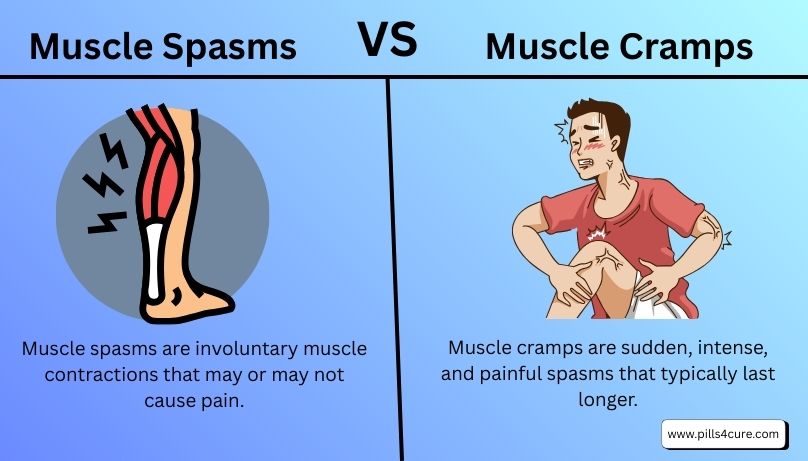Muscle pain can strike without warning, leaving you unsure whether it’s a muscle spasm or a muscle cramp. Although both conditions trigger discomfort and can disrupt daily activities, recognizing the differences between them is essential for proper treatment and long-term pain management.
What are muscle spasms? Muscle spasms are sudden, involuntary contractions of muscle fibers that cause sharp, shooting pain. The muscle spasm meaning refers to the automatic tightening of muscles beyond your control, which may last from a few seconds to several minutes.
In contrast, muscle cramps are prolonged, involuntary contractions that create a tight, knotted feeling in the affected muscle. These painful cramps can be severe, sometimes linked to dehydration, nutritional deficiencies, or underlying medical conditions.
For persistent or severe cases, doctors may recommend muscle relaxants such as baclofen, which work by calming overactive nerves and reducing muscle stiffness. Along with hydration, stretching, and lifestyle adjustments, baclofen tablets can provide effective relief and help restore normal muscle function.
Understanding Muscle Spasms: Causes and Symptoms
What Are Muscle Spasms?
Muscle spasms are sudden, involuntary contractions that can affect any muscle in your body. These sudden muscle spasms occur when nerve signals to the muscles become disrupted, causing the muscle fibers to contract rapidly and uncontrollably.
Primary Causes of Muscle Spasms
Understanding the reason for muscle spasms helps in prevention and treatment:
1. Nerve Irritation or Damage
- Pinched nerves
- Herniated discs
- Spinal stenosis
- Nerve compression
2. Muscle Overuse and Fatigue
- Repetitive motions
- Prolonged physical activity
- Poor posture
- Occupational stress on muscles
3. Dehydration and Electrolyte Imbalances
- Low sodium levels
- Potassium deficiency
- Magnesium insufficiency
- Inadequate fluid intake
4. Medical Conditions
- Multiple sclerosis
- Cerebral palsy
- Spinal cord injuries
- Stroke
Recognizing Muscle Spasm Symptoms
Signs of a muscle spasm include:
- Sharp, stabbing pain that comes on suddenly
- Visible muscle twitching or jerking
- Temporary loss of muscle function
- Muscle stiffness and reduced range of motion
- Pain that may radiate to surrounding areas
- Involuntary muscle movements that you cannot control
Muscle spasm symptoms typically last anywhere from a few seconds to several minutes, though some may persist longer depending on the underlying cause.
Understanding Muscle Cramps: When Pain Becomes Extreme
The Nature of Muscle Cramps
Muscle cramps represent prolonged, involuntary muscle contractions that cause intense pain and muscle hardening. Unlike spasms, cramps involve sustained contraction that can last from minutes to hours in severe cases.
Common Causes of Muscle Cramps
Immediate Triggers:
- Muscle cramps when stretching often occur due to sudden muscle lengthening
- Dehydration during physical activity
- Overexertion and muscle fatigue
- Poor blood circulation
Underlying Conditions Leading to Full Body Cramps: Understanding full body cramps causes is essential for comprehensive treatment:
- Kidney disease
- Thyroid disorders
- Diabetes
- Liver disease
- Peripheral artery disease
- Medication side effects
Severe Body Muscle Cramps: When to Worry
Severe body muscle cramps may indicate serious underlying conditions:
- Neurological disorders
- Metabolic imbalances
- Vascular problems
- Autoimmune conditions
After cramps muscle pain is common and can persist for hours or days, indicating tissue damage or inflammation from the intense contraction.
Pain Comparison: Spasms vs Cramps
Intensity and Duration
Muscle Spasms:
- Sharp, shooting pain
- Brief duration (seconds to minutes)
- Sudden onset and resolution
- May cause temporary muscle weakness
Muscle Cramps:
- Deep, sustained aching pain
- Longer duration (minutes to hours)
- Gradual onset with persistent pain
- Often leaves residual soreness
Location and Spread
Muscle Spasms:
- Can affect any muscle group
- May involve multiple muscles simultaneously
- Often affects back, neck, and leg muscles
Muscle Cramps:
- Commonly affects calf, thigh, and foot muscles
- Muscle cramps all over body may indicate systemic issues
- Usually involves specific muscle groups
Medical Conditions and Muscle Pain
What Diseases Cause Muscle Cramps?
Several medical conditions can trigger chronic muscle cramping:
Neurological Disorders:
- Amyotrophic lateral sclerosis (ALS)
- Peripheral neuropathy
- Charcot-Marie-Tooth disease
- Spinal muscular atrophy
Metabolic Conditions:
- Diabetes mellitus
- Hypothyroidism
- Chronic kidney disease
- Liver cirrhosis
Vascular Issues:
- Peripheral artery disease
- Venous insufficiency
- Deep vein thrombosis
Autoimmune Disorders:
- Lupus
- Rheumatoid arthritis
- Myositis
Treatment Options and Medications
Muscle Spasms Medication
First-Line Treatments:
- Over-the-counter pain relievers (acetaminophen, ibuprofen)
- Topical analgesics
- Heat and cold therapy
- Gentle stretching and massage
Prescription Medications:
- Muscle relaxant baclofen is commonly prescribed for severe spasms
- Cyclobenzaprine (Flexeril)
- Tizanidine (Zanaflex)
- Diazepam (Valium) for short-term use
Advanced Treatment Options
Physical Therapy:
- Targeted exercises
- Manual therapy techniques
- Posture correction
- Ergonomic training
Injection Therapies:
- Botulinum toxin injections
- Trigger point injections
- Nerve blocks
Nutritional Support and Supplements
Essential Muscle Cramps Supplements
Electrolyte Management:
- Magnesium: 400-800mg daily
- Potassium: 3,500-4,700mg daily
- Calcium: 1,000-1,200mg daily
- Sodium: Adequate replacement during exercise
Additional Beneficial Supplements:
- Vitamin D: 1,000-2,000 IU daily
- B-complex vitamins
- Omega-3 fatty acids
- Coenzyme Q10
Hydration Strategies
Proper hydration is crucial for preventing both spasms and cramps:
- Drink 8-10 glasses of water daily
- Increase intake during physical activity
- Include electrolyte-rich beverages during intense exercise
- Monitor urine color as a hydration indicator
Prevention Strategies
Lifestyle Modifications
Exercise and Movement:
- Regular stretching routines
- Gradual warm-up and cool-down periods
- Strength training to support muscle health
- Low-impact activities like swimming and yoga
Ergonomic Improvements:
- Proper workplace setup
- Supportive seating and mattresses
- Regular position changes
- Stress management techniques
Dietary Considerations
Foods to Include:
- Leafy green vegetables (magnesium)
- Bananas and oranges (potassium)
- Dairy products (calcium)
- Nuts and seeds (multiple minerals)
Foods to Limit:
- Excessive caffeine
- Alcohol
- Processed foods high in sodium
- Sugary drinks that can affect electrolyte balance
When to Seek Medical Attention
Red Flag Symptoms
Consult a healthcare provider immediately if you experience:
- Muscle cramps or spasms lasting more than 10 minutes
- Severe pain that doesn’t respond to home treatment
- Recurring episodes without apparent cause
- Associated symptoms like fever, swelling, or skin changes
- Difficulty breathing or swallowing during episodes
- Weakness or numbness following spasms or cramps
Professional Evaluation
A healthcare provider may recommend:
- Blood tests to check electrolyte levels
- Neurological examination
- Imaging studies (MRI, CT scan)
- Electromyography (EMG) testing
- Specialized referrals to neurologists or rheumatologists
Precautions and Safety Guidelines
Important Safety Considerations
Before Starting Any Treatment:
- Consult with your healthcare provider
- Disclose all medications and supplements
- Report any underlying medical conditions
- Discuss pregnancy or nursing status
Medication Safety:
- Follow prescribed dosages exactly
- Be aware of potential drug interactions
- Monitor for side effects
- Don’t abruptly discontinue muscle relaxants
Exercise Precautions
Safe Exercise Practices:
- Start slowly and gradually increase intensity
- Maintain proper hydration before, during, and after exercise
- Use proper form and technique
- Listen to your body and rest when needed
Warning Signs to Stop Activity:
- Sudden, severe muscle pain
- Dizziness or lightheadedness
- Chest pain or shortness of breath
- Excessive fatigue or weakness
Frequently Asked Questions (FAQs)
Q1: What’s the main difference between muscle spasms and muscle cramps?
A: The primary difference lies in duration and intensity. Muscle spasms are brief, sharp contractions lasting seconds to minutes, while muscle cramps involve sustained, painful contractions that can last much longer and cause deep, aching pain.
Q2: Can stress cause muscle spasms and cramps?
A: Yes, stress can trigger both conditions. Chronic stress increases muscle tension, depletes essential nutrients, and can disrupt nerve function, leading to involuntary muscle contractions.
Q3: How long do muscle spasm symptoms typically last?
A: Most muscle spasms last from a few seconds to several minutes. However, the affected muscle may remain tender or sore for hours or days afterward.
Q4: What diseases cause muscle cramps throughout the entire body?
A: Systemic conditions like kidney disease, thyroid disorders, diabetes, liver disease, and certain neurological conditions can cause widespread muscle cramping.
Q5: Is the muscle relaxant baclofen safe for long-term use?
A: Baclofen can be used long-term under medical supervision, but it requires careful monitoring for side effects and gradual dose adjustments. Never discontinue baclofen abruptly, as this can cause withdrawal symptoms.
Q6: What supplements help prevent muscle cramps?
A: Key supplements include magnesium (400-800mg daily), potassium, calcium, and vitamin D. However, consult your healthcare provider before starting any supplement regimen.


